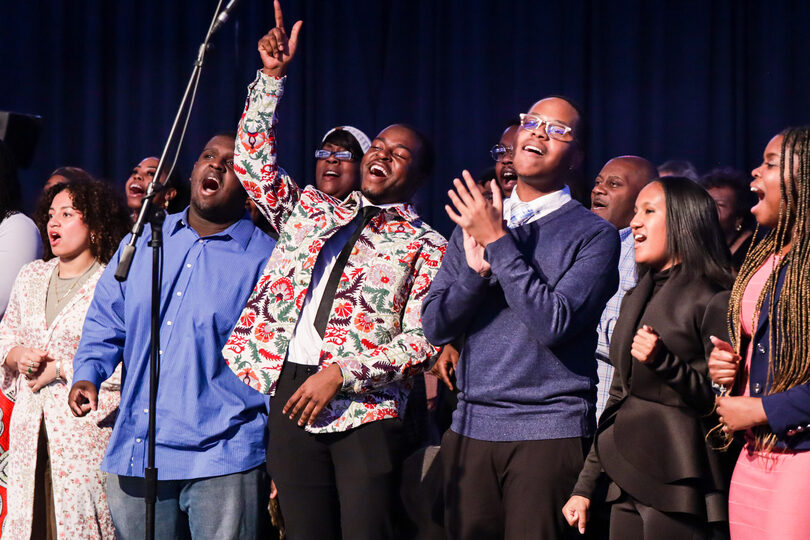SU honors MLK Jr. with ‘The Reach of the Dream’ celebration

Chelsea Reeves | Contributing Photographer
"The Reach of the Dream" was the theme of this year's annual Rev. Dr. Martin Luther King Jr. Celebration. More than 2,000 people attended the event which included an art gallery, dinner and keynote presentation by Talithia Williams.
Get the latest Syracuse news delivered right to your inbox.
Subscribe to our newsletter here.
Over 2,000 people gathered Sunday for Syracuse University’s 39th annual Rev. Dr. Martin Luther King Jr. Celebration, the largest university-sponsored event in the nation to honor Dr. King.
The celebration, held in the JMA Wireless Dome, featured keynote speaker Talithia Williams and the event’s second-ever specially curated art exhibition, showcasing work on loan from Light Work and seven local artists. The artists and speakers all embodied “The Reach of the Dream” — the theme of this year’s event.
“The reach of the dream is such a fitting theme because it alludes to the enduring impact and the influence of Dr. King’s dream,” Talithia Williams said. “His dream really extends beyond just the speeches and the sermons to get quoted. It also touches on sort of the broader impact of the struggle for justice and equality; for women’s rights, human rights, gender equity.”
In 2014, Talithia Williams became the first Black woman to receive tenure at Harvey Mudd College, where she now serves as the associate professor of mathematics and director of the Mathematics Clinic. In her presentation, Talithia Williams spoke about her personal experiences as a Black woman, specifically navigating the STEM field and education system, to highlight how far society has come and how far it has to go since King was alive.
“Every day it seems like we grow one step closer to becoming a society where individuals are actually judged by the content of their character, not the color of their skin,” Talithia Williams said. “At least most days. Some days we take two steps back, but most days we look forward.”
Talithia Williams said her mother was 20 years old when King was assassinated.
“She would often tell me stories growing up in Columbus, Georgia. Stories of having to ride the bus to school at 5-years-old, and her uncle taught her to walk all the way to the back because that’s where you sit, the back of the bus,” Talithia Williams said. “She eventually became a school teacher. And she taught for 30 years and she taught me the importance of education as a tool for social mobility so that I could fully engage in every part of society.”
Her mother’s work in education encouraged her to attend Spelman College as an undergraduate student.
“That was the first place that I met African American women mathematicians and chemists and scientists and physicists and economists,” Talithia Williams said. “All of a sudden I saw Black women doing everything.”
Since 2010, Talithia Williams has organized a conference called Sacred Sistahs for Black and Hispanic middle and high school girls in Southern California. Talithia Williams said the conference helps young girls find their passions for STEM programs in higher education.
“Each year we bring girls to (Harvey Mudd’s) campus. A lot of them have never been there,” Talithia Williams said. “Recently I had a young lady reach out to me, a fourth grader. Interestingly, in the email, she said, ‘Dr. Williams, our class is having a Black history program and I want to dress up as you for Black History Month.’”

Chelsea Reeves | Contributing Photographer
Talithia Williams, the event’s keynote speaker, shared her experiences navigating the education system and STEM field as a Black woman. She was the first Black woman to receive tenure at Harvey Mudd College.
I had a young lady reach out to me, a fourth grader. Interestingly, in the email she said, 'Dr. Williams, our class is having a Black history program and I want to dress up as you for Black History Month.'Talithia Williams
Leondra Tyler, a senior and student coordinator of engagement programs for Hendricks Chapel, co-chaired the event with Rev. Brian Konkol, dean of Hendricks. Tyler said she felt especially connected to this year’s theme.
“On a personal level, this theme is very important to me as I am a non-traditional student that did not receive a high school diploma,” Tyler said. “And here I stand with you all tonight, against all odds, about to graduate with a bachelor’s in neuroscience and psychology.”
Each year at the MLK celebration, SU honors a group of “Unsung Heroes” for their dedication to the community and expression of King’s values. The awards are given to members of the Syracuse community who have made an impact on the lives of others but do not often receive recognition for their contributions, according to an SU news release.
Iris St. Meran, emcee of the event and co-host and producer of “Bridge Street” — Syracuse television’s only live, local morning show — presented the 2024 Unsung Hero Awards, which honored Murjan Abdi, Sharon Dotger, Elbethel Berhane and Mia-Marie Fields.
Prior to the speaker event, attendees had the opportunity to interact with the local artists and their work in the Club 44 VIP lounge.

Chelsea Reeves | Contributing Photographer
Cjala Surratt telling the stories behind photography curated for the gallery. Pieces on loan from Light Work by local Black photographers marked the beginning of Surratt’s gallery tour.
Cjala Surratt, an SU alumna, was part of the cohort that curated the art gallery. She said the cohort chose the theme “legacy” in their selection process.
“We did a lot of thinking about how established artists and emerging artists champion each other and work together,” Surratt said. “It’s really about our past, our present and how we cultivate and champion the artists of the future — particularly Black artists of the future.”
The gallery featured four “established artists,” all of whom have taught at SU, and three younger emerging artists, who are all from the Syracuse area. The gallery also featured images curated from Light Work.
London Ladd, critically acclaimed artist, SU alumnus and instructor of illustration in the School of Art, showed three paintings and three children’s books. He chose to show these specific pieces because they reflect the legacy theme as well as intergenerational connection.
“My books are very centered on, just, Black lives. More than just the ‘civils.’ The civil rights era, more than the slave era. There’s history happening right now,” Ladd said. “The work that you see … I want to make sure anyone can see themselves in it. Not just one particular person, one particular story.”
SU Assistant Professor of Art Therapy Rochele Royster, internationally-renowned artist and Emeritus Professor of ceramics David MacDonald and ceramicist Sharif Bey, who was mentored by MacDonald and is now associate professor of art at SU, were also featured as established artists.
Both MacDonald and Bey work with and mentor “emerging artist” Brandan Meyer, a ceramicist who primarily works in Oswego and Syracuse. One of his featured pieces was a collection of ceramic plates painted with patterns depicting the city of Syracuse. It reflected the impacts of the Interstate-81 project on the local Black community.
“I wanted the pattern(s) to represent the migration of the people from the 50s, the world after they got pushed out. Then, I broke the centerpiece, purposefully. I reassembled it more so as a symbol of hopefulness, that once the highway is torn down, we can hopefully reconcile that history,” Meyer said. “It’s not going to be perfect, because, you know, people were displaced. At least, like, an effort is being made.”
Every day it seems like we grow one step closer to becoming a society where individuals are actually judged by the content of their character, not the color of their skin. At least most days. Some days we take two steps back, but most days we look forward.Talithia Williams
Other “emerging artists” included Iris Williams, digital artist, and Melquea Smith, children’s book illustrator and author. Both are Syracuse natives.
“My main mission (with) my art is just to incorporate Black women in more of a positive, uplifting kind of way,” Iris Williams said. “I’m just happy that I’m able to do this. Because honestly, back then we weren’t able to do none of this, you know, so I’m just happy to have that opportunity.”
Jamesville-DeWitt High School students Jonah Britt, Bernicia Appiah and Denaya Eudell attended the event as an activity for their club, UMOJA.
“It’s about unity,” Appiah said. “We come together and we teach our school about Black history and African history.”
UMOJA is “a community and critical resource dedicated to enhancing the cultural and educational experiences of African American and other students,” according to its website. The word “Umoja” means unity in Kiswahili.
“I really liked how (Talithia Williams) was able to incorporate mathematics with Martin Luther King,” Appiah said. “It was unexpected, but I learned a lot.”
At the end of her speech, Talithia Williams reminded the audience of how far King’s dream has reached, both in education and broader society.
“I want to leave you with this quote by Dr. King…when he was receiving the Nobel Peace Prize, he said ‘I have the audacity to believe that people everywhere can have three meals a day for their bodies, education (and culture) for their minds and dignity, equality and freedom for their spirits,’” Talithia Williams said.





